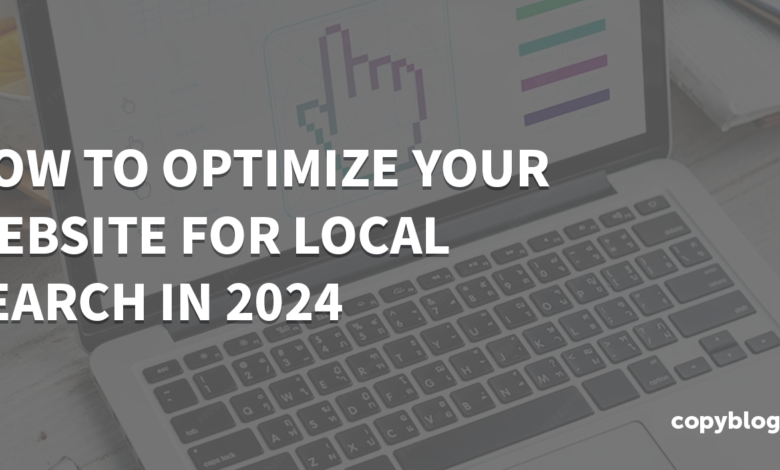How To Optimize Your Website For Local Search

Most local business owners have tried a few local SEO tips, but it’s easy to get lost in the weeds of technical tips and feel overwhelmed by Google’s complex algorithm.
The good news is that you don’t need to fully understand how the algorithm works to rank on Google.
This is because Google’s goal is to give searchers the best results, and the algorithm is engineered to identify quality businesses – not businesses with the best optimization. If you offer a high-quality product or service and deliver a great customer experience, you’re already 80% of the way to SEO success.
If you already have a great business, this simple guide to local SEO (which doesn’t require technical knowledge to implement) will help you effectively communicate to search engines and searchers that your business is the best solution and ultimately rank at the top of the search results.
Want us to
scale your traffic?
For the first time, The Copyblogger methodology is now available to a select few clients. We know it works. We’ve been doing it since 2006.
How Google’s Local Search Algorithms Works
Google’s algorithm is a highly complex machine that uses different signals, such as information on the product and/or service pages, quality and quantity of reviews, and each business’s location, to determine which business is “best” for each searcher.
You don’t need to understand exactly how the algorithm works to rank. However, Google revealed on its support page that these are the three most important ranking factors that the algorithm considers when ranking local websites:
- Relevance
- Distance
- Prominence
It also defines each of these three factors.
Relevance
Relevance means that your business sells the products or services the searcher wants. For example, if a searcher is looking for a yoga studio, a website specializing in yoga will likely rank higher than a generic gym.
We’ll also discuss what a Business Profile is below (and how to set one up and optimize it).
Distance
Next, Google wants to ensure that the store’s physical location is relatively close to the searcher. Alternatively, if the searcher doesn’t allow Google to know their location or isn’t located where they’re searching from (e.g., they’re in Virginia and looking up restaurants in Las Vegas for an upcoming trip), the algorithm might look at which shops are centrally located in the city.
Prominence
Consider prominence as business quality (product/service quality, customer service, cleanliness, etc.).
Consider two yoga studios located close to one another.
How does Google know which yoga studio offers better/higher quality classes? While the algorithm obviously can’t attend the classes, there are online signals it can use to judge quality.
For example, if one yoga studio has many positive reviews and is frequently mentioned by local influencers across the web, Google will assume that its yoga classes are of better quality. As a result, Google will likely rank it above the one with few reviews or mentions from local influencers.
As you can see, the algorithm is essentially designed to evaluate all of these online signals to determine which business is best for the searcher.
However, there are ways you can leave more signals to Google (and searchers) that your business is the best result.
In the yoga studio example mentioned above, it is possible the studio with no reviews and no mentions from influencers actually does offer higher quality classes.
And that is where local SEO comes in.
Assuming you already have a high-quality business and happy customers, you can leverage these local business optimization tips to communicate more effectively how and why your business is the best solution for the searcher.
Let’s jump into it.
Step 1: Claim Your Google Business Profile
While this post is about optimizing your website for local search, it’s essential to ensure you have a Google Business Profile set up. Doing so allows a card like this to show up when people search for your business:
Setting up a Google Business Profile will also help your website show up in these results, which are referred to as the map pack. These results are common in location based searches like “best (your type of shop) in (city).”
It only takes a few minutes to set up a Google Business Profile, and there’s a guide on how to do it here.
The biggest challenge is verifying your listing, as physical locations must submit a code sent via postcard. Google does this to ensure the physical location entered exists.
However, setting up a Google Business Profile does not guarantee you will show up in the search results. It’s more of a prerequisite to competing in the rankings. Once you’ve set up your Google Business Profile, you still need to optimize it (and use the tips below) to outrank the competitors.
To start optimizing your Google Business Profile, here’s a simple checklist:
- Business name
- Address
- Phone number: Ideally, a local phone number
- Website
- Hours
- Attributes: For example, wifi, outdoor seating, etc.
- Category: Pro Tip: Select a specific category. E.g., “nail salon” instead of “salon”
- Products and Services: People can order directly using these features
- From The Business: This is where you can write a short description of your business
- Questions and Answers: Respond to any questions from customers
You’ll also have an opportunity to upload photos and videos. These not only help from an SEO perspective, but they also make your business significantly more attractive to potential customers and increase clicks, which is the end goal of any marketing effort.
Here’s a great example of a well-optimized Google Business Profile:
You’ll notice that the example above also included events. In addition to events, Google Business Profile offers plenty of these additional information boxes, such as food ordering, online bookings, and more, which can help you drive more conversions.
You can even add posts to your Google Business Profile, which help it appear more up to date for customers.
Step 2: Create Pages For Each Location/Services
You probably already have your home, contact, and about page set up, all of which are important. However, people evaluate and choose local businesses primarily based on the quality of the products and or services they offer and their location.
Therefore, the first step to optimizing your website for local search specifically is to create individual pages for each location and service you offer.
Here’s a great example of a website with multiple locations and individual pages for each one:
You’ll also notice that they show up in the local map pack for their Charlotte location:
As you create location pages, make sure that the information on each page is unique to that location. If the text is the same, you could have a duplicate content penalty.
A great way to make the content on each location page unique is to include information on the different staff at each location, reviews from that specific location, and even videos/photos of that location.
In addition to the location pages, create individual pages for each of the services your business offers.
For example, on this plastic surgery website, they offer an individual page for each surgery they offer:
This makes it easy for search engines and users to quickly understand what they offer and learn more about the service.
Below is a great example of a services page. It includes helpful information and answers common FAQs about the service, like what the surgery entails, the recovery process, and before/after pictures. This information makes it easy for a searcher to quickly evaluate the service and the business’s approach/quality.
Additional Pages FAQs:
Q: Can I add other pages in addition to services and location pages?
A: Yes, you can. For example, you might choose to offer a page dedicated to reviews, or if you have multiple different types of customers (e.g., corporate buyers versus individual buyers), you can have separate pages for each buyer persona with information that’s relevant to them. However, keep in mind that adding more pages to your website can make it messy for search engines and users to navigate, so only create pages that are necessary and helpful to users.
Each page on your website should target a primary keyword that potential customers might search when looking for your products/services.
You probably already vaguely know the types of search terms you want your website to show up for, but there are usually several variations of keywords.
For example, all of the keywords below (Austin auto shop, Austin auto service, etc.) are fairly similar, but you can only insert one into the title of your page. So you’ll rank for several of these keywords, but choose just one to be your primary target keyword.
So, which keyword should you select? And how do you find a list of potential keywords?
The easiest way to find keywords is to do a quick search for any term that a potential customer might Google when looking for a particular service you offer. For example, if you offer plastic surgery, you might search “rhinoplasty” and your city name.
Then, click on the top result that takes you to a service page (not just a homepage) and copy that URL:
Then, paste the URL into Ahrefs or SEMrush. Next, click on “organic keywords” to see the specific keywords that it ranks for.
It’s a good idea to use a handful of these keywords throughout the page, but pick one primary keyword.
As a general rule, select the keyword with the highest search volume (the keyword that receives the most monthly searches from users) that your website can realistically rank for.
Some keywords are much more difficult to rank for than others because other high authority websites are also targeting that keyword.
Google gives preference to these high authority websites, which can make it very difficult for newer and lower authority websites to outrank them when competing for the same target keyword.
While Google doesn’t have any proprietary metrics on the authority of the websites it crawls, various third party SEO tools offer metrics that do help you gauge the authority of a website. This metric is often referred to as “domain rating” or “domain authority”), and they use that to calculate the difficulty of a keyword (often referred to as “keyword difficulty”).
We’ll discuss how you can boost your website’s authority later in this post (it’s usually about earning local backlinks), but in the meantime, you can use this chart below as a general guideline to help you gauge how difficult of a keyword you can target.
Note that these are just very general guidelines and are not meant to be hard and fast rules, but rather general guidelines to help you get started.
If you’re not sure what your website’s domain authority is, just enter its URL into Ahrefs or SEMrush and those tools will tell you.
Local Keyword Research FAQ:
Q: Do I need to target a keyword for each page of my website?
A: No, your contact and about us pages do not need to target a keyword. Additionally, your homepage should only target your core keyword. For example, if you offer plastic surgery in Austin, your core keyword would be “plastic surgery Austin.” Alternatively, if you offer multiple locations in one state, you might just target “plastic surgery Texas” on the homepage. Or, if you offer services nationwide, you can just target “plastic surgery” and ensure that each location page targets the city.
Now that you know which pages should include on your website and the primary keyword each one should target, how do you actually optimize that specific page to rank for that keyword?
First, include the main keyword in the title tag and create a compelling meta description. If you’re using WordPress, you can use a tool like Yoast SEO to do this:
If you’re using a different website builder (Squarespace, Wix, etc.), you can simply search for the website builder name and “title tag and meta description” to quickly find a guide on how to add this to each page.
Additionally, it’s a good idea to use H1s, H2s, and H3s throughout your website. Ideally, include related keywords within these H2s and H3s whenever relevant/possible. For example, if the primary keyword is “Austin M&A lawyer,” you might include “M&A attorney in Austin” in one of the H2s or H3s (if you can find a relevant way to incorporate the keyword).
Finally, the key to ranking your services pages is simply providing relevant information that a searcher might want to know about that particular service.
Again, if you satisfy users by giving them all the information they might need to know, search engines will be more inclined to rank your website because they want to deliver the most satisfying search result to users.
If you’re not sure what kind of information to include on each service page, look at your email inbox or think of your phone calls and make a list of all of the questions people usually ask when contacting you regarding that service. Then, simply list that information on the service page.
For example, this page on an injury lawyer’s service page provides a great overview of common questions a customer might have:
Therefore, it’s no surprise that it’s currently ranking first for the search term “Accident Lawyer Austin.”
Step 5: Add Internal Links
It’s frustrating to visit a website and not be able to find the information you’re looking for. Additionally, if users can’t find the information they’re looking for, search engines will have difficulty finding the content.
As a general rule, it shouldn’t take visitors more than two or three clicks from the homepage to find any page on your website.
So be sure to include your services and location pages in the main menu:
You’ll also notice the arrows in the graphic above where the subpages have arrows pointing to one another.
This is because, in addition to linking to the main service and location pages in the main menu, it’s also beneficial from an SEO standpoint to internally link to other relevant pages from each individual service/location page.
For example, on this page on M&A law, you’ll see from its URL that it’s a subpage of their general business law page (URL is https://fergusonlawpractice.com/business-law/mergers-acquisitions/). Within the text on the page, they internally link to the general law page:
And if you click on the internal link, it takes you to this general law page (the URL for the general law page is https://fergusonlawpractice.com/business-law/):
Internal links make it easier for search engines to quickly find and index these pages, which will help them rank faster.
Step 6: Implement Local Business Schema
Schema helps Google understand that you are a local business, which can help it rank higher in search results. Here’s how Google explains local business schema:
So what Schema is available and how do you add it to your website?
Schema.org has a detailed guide on the different types of local business schema available.
However, this guide from HubSpot provides a helpful overview of Schema and a straightforward overview of how to implement it on your website.
Additionally, if you’re using WordPress, you can use a plugin like Yoast to easily add schema to your website.
Step 7: Add Your Business To Local Directories
By this point, your website is fairly well optimized for local SEO, but it still might not be ranking for your target keywords. This is likely because it doesn’t have enough authority to outrank other more authoritative competitors.
The key to boosting a website’s authority is showing Google you’re a credible and active business. One way to signal to Google that you’re a legitimate and active business is to add your business to directories like Yelp, Angies List, and any others relevant to your industry or local community.
Adding your business to directories is known as citation building. If you’re not sure which directories you should add your website to, you can use a citation tool like Bright Local or Whitespark to speed up the process.
It’s also critical that your name, address, and phone number (NAP) is consistent across all the directories you add your business to. Otherwise, it sends mixed signals to users and search engines, which will hurt your credibility and ultimately negatively affect your rankings.
Encourage customers to also leave reviews on these directories to further increase your credibility.
Step 8: Earn Local Backlinks
Search engines want to send users to credible businesses with great reputations, but how can a search engine judge a website’s reputation?
The primary method search engines use to judge a website’s credibility is to look at other websites that link to your website. The thinking here is that if a highly authoritative website sends its visitors to your website through a backlink, that website must believe that your business is credible.
For example, if Harvard Law links to your law firm’s website, search engines will view that as a positive signal you’re probably a highly credible business if Harvard Law trusts you enough to send visitors to your website via a link.
Now if Harvard Law, Berkeley Law, and Stanford Law are all linking to your website, that’s even better.
Therefore, a high quantity of high quality websites linking to your website is ideal.
As you may have guessed, not all links are equally powerful. Higher quality websites with well established authority are much more powerful than small blogs. Therefore, focus your efforts on earning links from highly credible websites.
As a local business, it’s also important to earn links from other businesses located in your community. This signals to Google that you’re not only credible, but also relevant to that community, which will help you rank for search terms relevant to your city.
So how do you earn backlinks?
As you may have guessed, it’s quite difficult to earn a link from a website like Stanford or Harvard. On the other hand, local backlinks are very powerful for local businesses and tend to be easier to acquire.
Plenty of SEO companies have different outreach strategies for acquiring backlinks, though I’ve found that the most effective method to earn backlinks is to actively participate in your community.
For example, if you sponsor a local event, offer a scholarship, or collaborate with another local business, you’ll likely receive a backlink from those websites organically.
You’ll see here that all of the law firms sponsoring this event earned a backlink from this website that organizes local walks:
Instead of just thinking about how you can earn backlinks, consider how you can become more actively involved in your local community. Becoming involved in the community will not only help you earn links, but also potentially earn customers and word of mouth referrals by simply getting to know people in real life.
Step 9: Implement A Review Generation Strategy
When you evaluate local businesses as a customer, you probably check both the quantity and quality of each business’s reviews.
Search engines also use reviews to evaluate a brand’s credibility when determining ranking factors in the local map pack. A high quantity of quality reviews is also likely a positive signal to the algorithm that can likely help boost your rankings in the traditional organic search.
However, there are laws around review generation strategies. For example, it’s not legal to bribe people for a five star review.
In fact, the FTC announced on its website that it has proposed the following rule:
“The Federal Trade Commission proposed a new rule to stop marketers from using illicit review and endorsement practices such as using fake reviews, suppressing honest negative reviews, and paying for positive reviews, which deceive consumers looking for real feedback on a product or service.”
However, here are some things that you can do to encourage customers to leave reviews:
- Ask them in person to leave a review
- Provide a page on your website with instructions on how to leave a review
- Send an email or text message asking them to leave a review on your website.
The biggest problem with reviews is that most people simply don’t take the time to create them.
You probably don’t leave a review for every single local business you visit. However, if you think about the positive reviews you do leave, it’s probably for a business that either impressed you by going above and beyond with outstanding customer service or someone at that business made a genuine connection with you.
Therefore, in addition to asking people to leave reviews, focus on delivering truly outstanding services and connecting with customers on a more personal level.
Step 10: Create Social Media Pages
While social media isn’t a confirmed local search ranking factor, it can have an indirect impact on your SEO efforts.
For example, if you have many followers on social media and a local news station learns about your business, they might write a story on it and link back to your website, which would boost your SEO.
For example, Saint Honore Doughnuts in Las Vegas is famous on TikTok, with over 100,000 followers, and its founder also has over a million followers.
When you look at its backlink profile, you’ll notice that many of the links are from local news publications covering the story of the founder and her social media fame:
However, you don’t need to be a social media influencer to reap the benefits of social media.
Consistently posting interesting stories from your local business in a personable and relatable manner can help the business page build a social media following and potentially get your story picked up by a local publication.
How To Further Improve Your Local SEO
If you follow all of the steps in this guide, you’ll surpass plenty of your competitors, but if you’re still struggling to reach the top spot and want more support along the way, Copyblogger can help.
You can either join the Copyblogger Academy and go through our detailed courses on SEO, content marketing, copywriting, and more. You’ll also have the opportunity to ask questions and get feedback directly from Copyblogger CEO, Tim Stoddart.
Alternatively, if you’d prefer the team behind Copyblogger to just do the SEO work for you, reach out to the Digital Commerce Partners and we can see if our agency would be a good fit to grow your local business.





